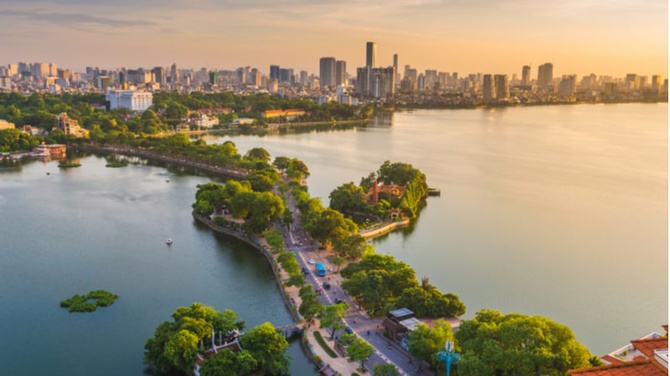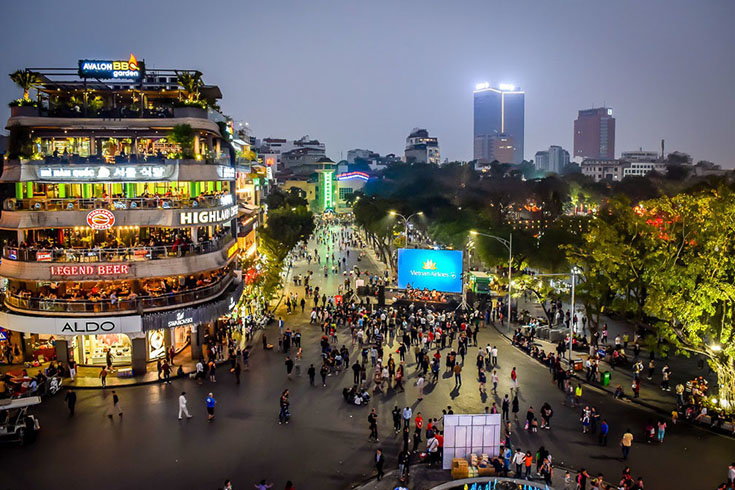The most northern “H” city we are going to cover for Vietnam is Hanoi. It covers approximately 1,300 square miles and is home to an astounding 7.6 million people in the extended area. Hanoi is the capital of Vietnam that is best known for its rich culture with Chinese,French and Southeast Asian influences.
Hanoi is also home to centuries old architecture and the heart of the city is home to the Old Quarter where its narrow streets are arranged according to types of trade. There are several little temples which includes the infamous Bach Ma that honors a legendary white horse
Hanoi’s Bach Ma Temple Weather

There is also the Dong Xuan Market that sells street food as well as household goods.
Hanoi’s weather is unlike any other in Vietnam. Although it is split into two main seasons, which include the rainy season (January through September) and the dry season (October to April),the other in between transition months allow Hanoi to actually experience all four seasons (spring, summer, autumn and winter).
This is something that might appeal to expats if they are used to experiencing, or would like to experience, the four seasons on an annual basis
Transportation

Traffic in Hanoi can be pretty wild and quite chaotic at times. Although it is a relatively large city area, there are millions of people packed into it and the streets are often overcrowded with buses, taxis, motorbikes, cars and pedestrians. For many new to the city, the experience can be somewhat daunting and overwhelming.
Traffic lights are a relatively new addition and they often go unnoticed or ignored by locals. The rules of the road, expats may be accustomed to elsewhere, are not widely followed in Hanoi. The markings for the traffic lanes and traffic signs in Hanoi are often also disregarded. Motorbikes can be encountered driving the wrong way down streets against traffic. Vehicles stop in the middle of traffic, rarely pulling to the side of the road to let others pass, leading to mass congestion.
Expats can find three main modes of transportation available to the public in Hanoi. One are the taxis which are metered, inexpensive and quite safe. The majority of taxi drivers are honest and some are willing to bargain for the price of the ride over turning on the meter, thus keeping the fare to themselves.
Another popular public mode of transportation is the Xe Om (pronounced seh ohm), or motorcycle taxis. There are more of these on the road than traditional taxis and are easily identified by the green helmets that the vast majority of the drivers wear. Expats choosing this method of travel must be prepared to haggle the price of the ride with drivers before getting onto the bike.
The price isn’t the only risky business when it comes to this method of travel. The drivers in Hanoi can be quite careless and have been seen spending a lot of time between fares drinking at beer stands. A lot of drivers do not provide a rider with a helmet which is against the law in all of Vietnam. Not only that, it puts the rider at great risk.
Another common mode of transportation are the Cyclos (3-wheeled bicycle taxis). Not all cities in Vietnam allow them, but they are quite common all around Hanoi. They can be seen carrying everything from passengers to large pieces of furniture. The cab portion of the cyclo is meant for two passengers, but is not uncommon to see four or five people squeezed into the tiny space. Cyclo fares also need to be confirmed up front and before getting onto one. Also, beware that they are slow and difficult to maneuver. However, most Cyclo drivers stay toward the edges of the street and are not as vulnerable to accidents.
The big city of Hanoi also provides many options for buses, trains and both domestic and international flights from its airport.
As previously discussed, there is always the option of owning. However, cost is very high and is often not worth the hassle and expense. And, with the major congestion on the roads in Hanoi, the stress of driving down those streets, possibly white knuckled from a death grip on the steering wheel, that many initially experience, may not be worthwhile.
We find using the major forms of public transportation to be the suggested way to get around though, especially when living close enough to the city, it is also easy to get around by walking or riding a bicycle.
While it is an option, owning a motorbike in Hanoi is only for the adventurous given the city driver’s general inability to follow traffic laws common elsewhere.
Food

With Hanoi being the capital of Vietnam and having the majority of the country’s population residing within its borders, there are many options for a wide variety of cuisine adventures.
Expats can find just about anything their palates desire including many types of western food including Italian, Greek food, Mexican food and so on. Again, you will find these foods much more expensive than those native to Vietnam. However, on nights where an expat just wants to have a pizza or burrito, why not splurge if the budget permits? The point is, there are many delicious options.
There aren’t any specific areas of Hanoi strictly dedicated to restaurants or food so expats can expect to explore and find a place to eat just about anywhere around the city. You can find restaurants crammed in between houses and there is also street food everywhere from main streets in Hanoi to the majority of the side streets as well.
The mobile street vendors set up shop wherever they please and will move depending on how well they business is doing. Expats probably shouldn’t expect to find a favored vendor in the same place from day to day. However, since there isn’t much in the way of regulation for street vendors especially, it is suggested to do some research on to find the safer recommended places to go when you first arrive in Hanoi.
Nightlife

Due to the size of Hanoi and that it is a place for tens of thousands of travelers to visit each year, there is plenty of things to do at night.
In addition to several bars, pubs, clubs and cafes that are open much past midnight, there are actually intriguing places to visit in the evenings in Hanoi.
Expats can visit West Lake, see a water puppet show on the river, visit the mausoleum, or hang out in the old quarter. Most of these places will close before midnight, but they all provide entertainment in the later evening hours.
In the old quarter is where expats will find most of the clubs and bars in the area. In this part of town, things tend to wrap up around midnight at which point the expat will have to head south to find bars and clubs catering to the later crowds.
Shopping
With major cities comes major shopping. There are streets dedicated to the sale of silk material and clothes. Bookstores, stamp shops, local crafts and other shopping are in abundance in Hanoi.
The Hang Da and Dong Xuan markets are indoors and have three floors of shops to browse. Expats moving to Hanoi with very little household goods, perhaps to save on shipping costs, they will find most everything they need at either of those markets or at the other shopping malls found within the city.
Recreational activities

In addition to the abundant nightlife in Hanoi the list of things to do during the day is also very extensive. From golf to cooking classes and everything in between, the expat will find something that suits their entertainment and recreational needs.
There are gyms all throughout the city for quality indoor exercise and if watching sports interests you, the university has several sports programs for their students which are open to the public to cheer on their teams.
Cost of living
The cost of living in Hanoi isn’t exponentially higher than most in Vietnam, but it can be at the higher end. Here are some general cost comparisons for an apartment in Hanoi, as well as some other expenses, related to living in the capital of Vietnam.
- One bedroom in the city centre area 8,200,000 VND per month
- One bedroom outside the city centre 6,100,000 VND per month
- Utilities including electric, heat, water and trash is 1,100,000 VND per month
- Internet at 60Mbps and cable is 230,000 VND per month
Even with the cost of living here in Hanoi being relatively higher than most places in Vietnam, with proper planning an expat can retire comfortably if this city is what they find appealing.